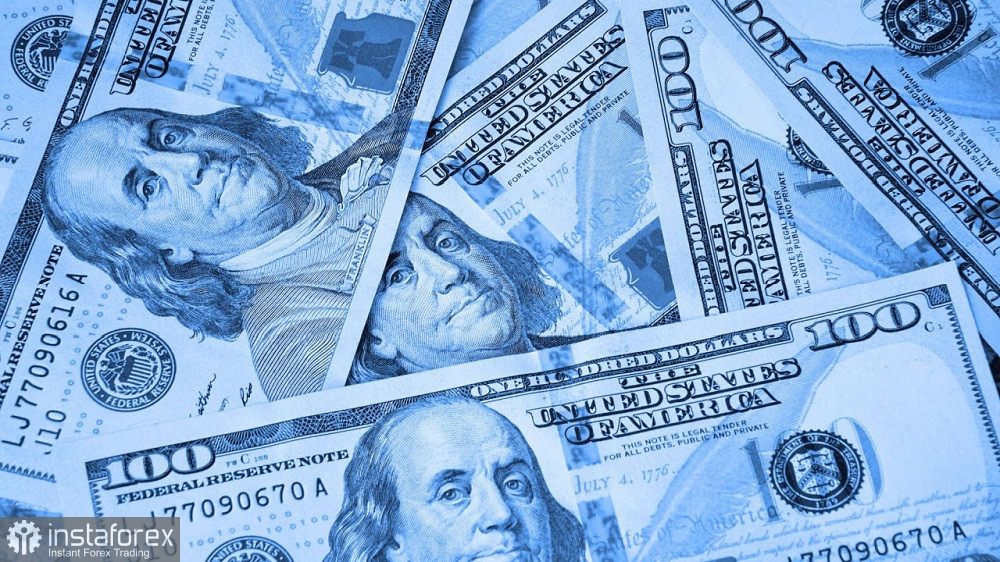The bears of the euro-dollar pair tested the support level of 1.0710 (the lower Bollinger Bands line on the D1 timeframe) yesterday but failed to overcome this target. Sellers clearly intended to enter the 1.06 area, but the downward momentum faded. After another optimistic remark by U.S. President Joe Biden (stating that default is not a threat to the United States), the market's attention shifted to the core PCE index, which will be published at the start of Friday's U.S. trading session.

Overall, the situation with the pair remains uncertain. Despite the optimistic statements from the White House, the situation remains unresolved: Republicans and Democrats have not yet reached a deal, despite less than a week remaining until the Treasury's announced deadline. Therefore, it is too early to talk about long positions on the EUR/USD pair. However, ignoring classical fundamental factors is not advisable, especially since an important inflation indicator will be published today.
Stalled Negotiations
Let's start with the negotiation track. It should be noted that the U.S. Congress routinely raises the debt ceiling without significant problems year after year—it is usually a quiet and non-politically sensational procedure. But not always. For example, in 2011, the standoff between President Barack Obama, the Democratic Senate, and Republicans in the House of Representatives lasted until the last moment. The threat of default was so real in the eyes of market participants that panic gripped traders. Standard & Poor's, a rating agency, made an unprecedented decision at that time, downgrading the long-term credit ratings of the United States from the maximum level of "AAA" to "AA+." A similar situation occurred in 2013 (although the credit ratings of the United States were not revised at that time), and a similar situation is unfolding again after 10 years.
This is to say that such crises are not an annual tradition but rather an exceptional situation. Considering the upcoming presidential elections in 2024 and the presence of "radicals" within the Republican party (who advocate against compromise and are open to default), market participants' concern is quite understandable. Biden's and negotiators' optimistic statements have limited impact as the situation is unfolding according to the worst-case scenario. For example, yesterday, the rating agency Fitch Ratings placed the U.S. credit rating at the "negative watch" level. This decision has already been commented on in the White House, stating that Fitch's conclusions "demonstrated the urgent need for a prompt resolution of the problem."
In other words, the U.S. credit rating is under threat for the first time in 12 years, and there is less than a week until the conditional deadline (June 1st). At the same time, negotiation groups are still far from reaching a deal. Such fundamental background does not contribute to the upward movement of EUR/USD.
Undoubtedly, the most likely scenario remains reaching a bipartisan agreement between Biden and McCarthy, resulting in Congress quickly approving a debt ceiling increase bill. It is assumed that the agreement reached will involve spending cuts—more than what the White House proposes but less than what Republicans offer.
The only question is when the deal will be reached, considering that there are only a few days left until the "zero hour." There is no doubt that until the end of the negotiation saga, the EUR/USD pair will remain under pressure due to increased demand for the safe-haven dollar.
Given such circumstances, one should exercise great caution in interpreting today's inflation release or, rather, the reaction to this release.
Core PCE Index
We are talking about the core personal consumption expenditures (PCE) price index in the United States. As it is known, this inflation indicator is closely monitored by the Federal Reserve with special attention, which is why it receives increased attention from the market.
Recall that last month, this indicator decreased to 4.6% on an annual basis, below the projected decline of 4.5%. The report provided support to the dollar, although overall, the release once again reflected a decrease in the indicator. From September to December of last year, the index consistently declined from 5.2% to 4.6%. Then, in January and February, the indicator reached a level of 4.7%, and in March, it returned to the December level of 4.6%.
According to preliminary forecasts, in April, the core PCE index is expected to reach 4.5% year-on-year, demonstrating a minimal decrease. If the report falls in the "red zone," the dollar may temporarily weaken across the market, and accordingly, the EUR/USD pair may rise towards the 1.08 level. However, I must reiterate that such price movements should be approached with caution, as "classic" fundamental factors currently have limited influence on dollar pairs.
At the same time, as soon as American policymakers reach a compromise, the focus will once again shift to inflation and the prospects of a Federal Reserve interest rate hike. The fundamental picture for the EUR/USD pair will change drastically in such a case, and by many indications, not in favor of the greenback. Therefore, at the moment, it is advisable to take a wait-and-see position for the pair.
 English
English 
 Русский
Русский Bahasa Indonesia
Bahasa Indonesia Bahasa Malay
Bahasa Malay ไทย
ไทย Español
Español Deutsch
Deutsch Български
Български Français
Français Tiếng Việt
Tiếng Việt 中文
中文 বাংলা
বাংলা हिन्दी
हिन्दी Čeština
Čeština Українська
Українська Română
Română

